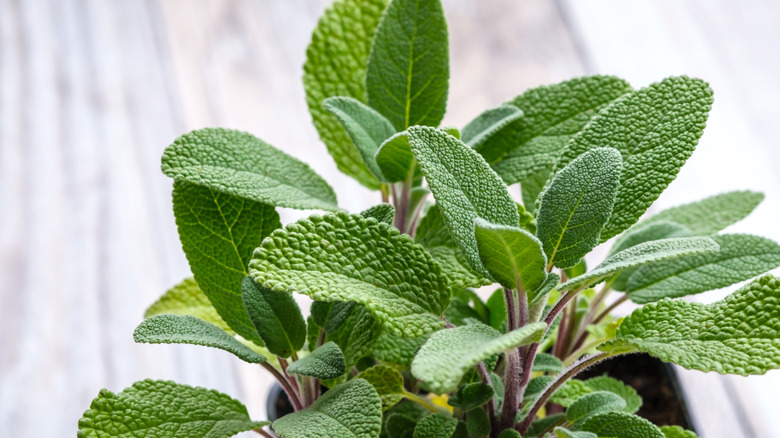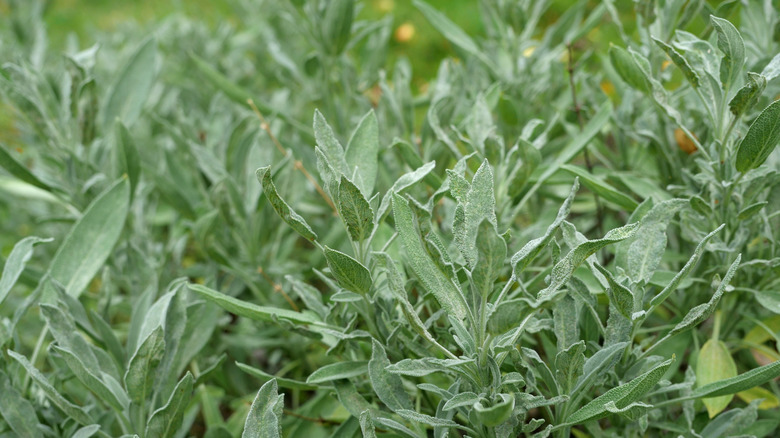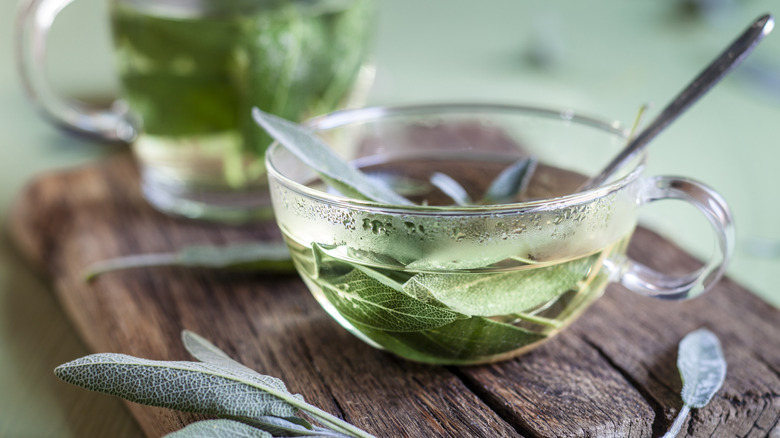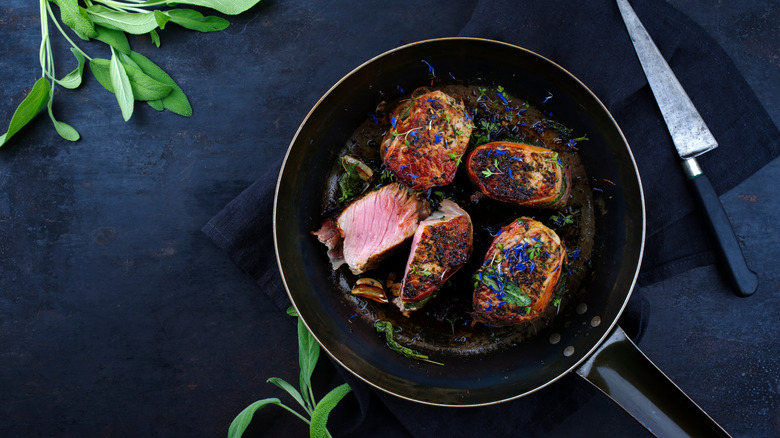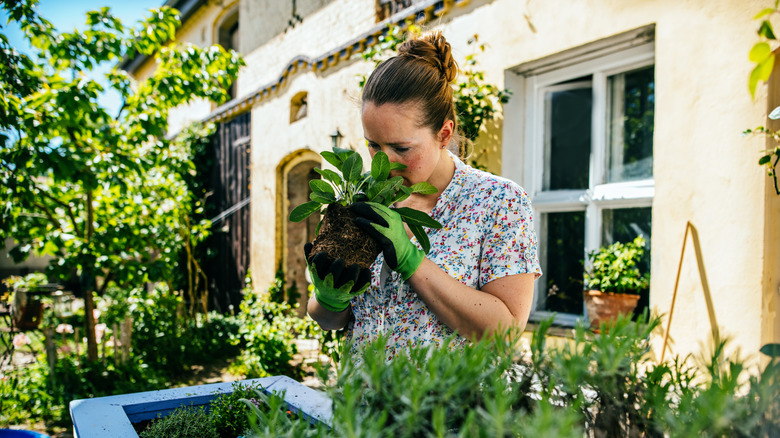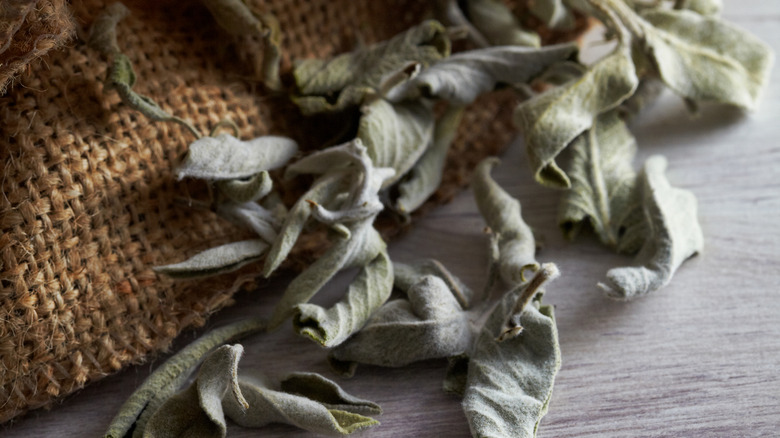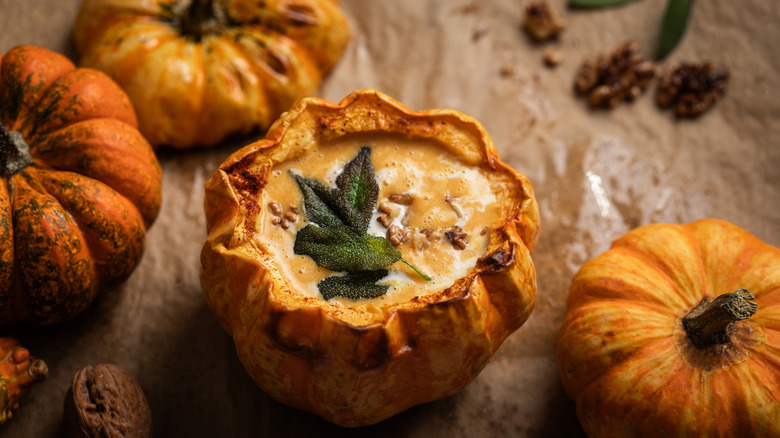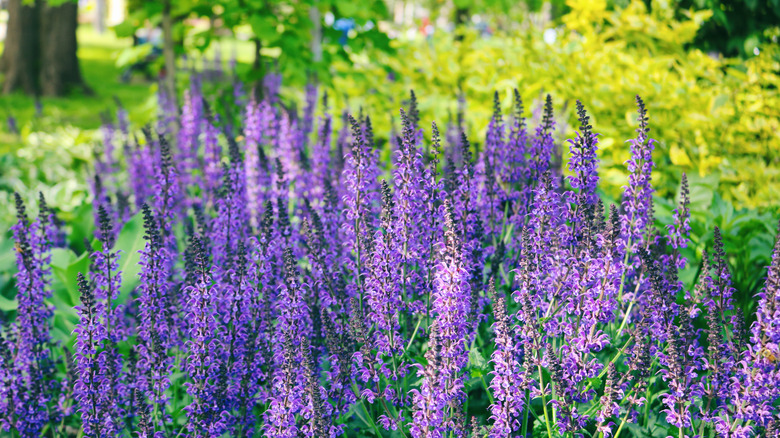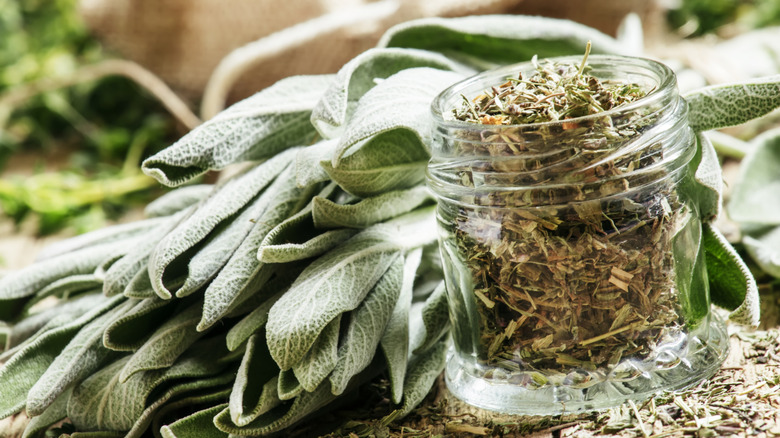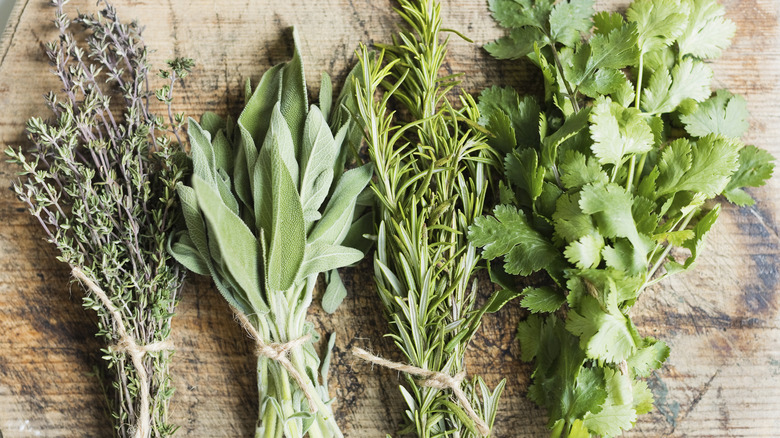The Everything Guide To Cooking With Sage
We may receive a commission on purchases made from links.
Sage is an ancient herb, honored in songs such as Simon & Garfunkel's "Parsley, Sage, Rosemary, and Thyme," whose lyrical roots stretch back hundreds of years to the 17th century song, "Scarborough Fair," itself an homage to something older: a Yorkshire market that got its start in the 14th century. Sage's roots go back even further than that, of course, to the Ancient Mediterranean, but we're getting ahead of ourselves.
The real question is, why is sage so great? In addition to being flavorful both fresh and dried, it is amenable to a wide variety of culinary approaches. It pairs extremely well with pineapple, for instance, and is a star feature in Italian seasoning. It is delicious with upscale dishes, such as pumpkin ravioli, too, and it gets a major flavor boost when you fry your herbs before using them in meats and sauces.
Although it's a simple enough ingredient and found in cuisines across the world, it is often underutilized in American cooking, confined to stuffing a Thanksgiving turkey once a year. It is much more prevalent in European and Latin cooking, though, so every home chef should know how to use it.
What is sage?
Sage (Salvia officinalis) is a fragrant herb in the same family as mint and other aromatic herbs, called Lamiaceae. It is native to the Mediterranean, living happily in sunny conditions on coastlines, hills, and mountains. The green-gray color of its leaves is a defining characteristic of sage, along with a beautiful soft texture and bluish-purple flowers that look lovely in the garden all through spring and summer. Their fragrance attracts a variety of pollinators, so even people who don't much like to cook consider it a wonderful garden specimen.
Common sage is also known as culinary, garden, kitchen, or true sage, its names varying according to location and brand. Because it is so flexible — working as well in sauces and stews as it does in pasta or even dessert — you will find many different varieties in stores and at farmers markets, a way to boost your creativity in the kitchen.
A brief history of sage cultivation and use
Although it is always hard to offer specific locations of origin for plants with ancient histories, sage is believed to hail from the Balkan peninsula. For millennia, people have relied on sage both medicinally and culinarily, though the former was its more common use among ancient peoples, including Greek, Roman, Chinese, and Arabic communities.
Sage has been credited throughout the centuries with a staggering array of abilities. During the Renaissance, herbalists credited sage with boosting brain health, improving the senses and memory, reducing palsy, and strengthening sinews. Arabic doctors took it a step further and believed sage even had immortality properties. If only, right?
Sage seems to have become much more popular as a cooking ingredient by the end of the Middle Ages in Europe. Thomas Jefferson, renowned for being a U.S. president who loved to spend time in the garden, grew sage at his sprawling hilltop Virginia estate, Monticello. From there, its usefulness and fame only spread.
Sage in global cuisines
Although many Americans use sage in culinary traditions descended from European ancestors, other cooks residing in the U.S. follow foodways rooted in African, Latin, and Asian practices. Somali cuisine, for instance, leans heavily on a spice profile that includes cumin, cloves, cardamom, cinnamon ... and sage, just for a break in the Cs. In many Asian cuisines, you might find it paired with garlic, ginger, and lemongrass to accompany meat or tofu.
Sage also finds a happy home in beans, sausages, and veggies, which explains its presence in cuisines, such as Mexican. Known for hearty food that sticks with you, Mexico loves strong flavors that can stand up to the rich umami of meats and starches that comprise much of the diet.
Then, of course, there's Europe. In the United Kingdom, artisans add sage juice or chopped sage leaves to cheese curd to create Sage Derby cheese, a famous delicacy from the area. Italians adore sage as well, adding it to dishes such as saltimbocca, which adds prosciutto and sage leaves to veal cutlets before frying up the whole thing.
The flavor of sage
Sage has a deep flavor with a fresh, peppery taste. Other adjectives used to describe sage include piney, earthy, minty, and citrusy, which can vary according to the type of sage. On its own or fresh, sage is strongly herbal in nature, which means it makes a great tea, but you have to be careful how you use it in cooking, as it can quickly become overpowering.
The aroma of sage is quite strong, with some people comparing it to the smell of camphor, an anti-inflammatory and pain-relieving compound that is often used in lotions or creams. Although that might sound a little off-putting, sage used in the right quantities adds a delicate, spicy, ever so slightly hot scent and taste to dishes in which it's used. It's definitely a plus if employed correctly, but because it's so strong, you might want to use it in exact recipes before you start to experiment on your own.
Common varieties of sage
What you consider to be "sage" depends on whether you look at its genus, Salvia, which contains more than 900 species native to different regions across the world, or just common sage and its cultivars. If you want to get the most out of cooking with sage, though, it pays to look beyond the common variety to unique twists. Depending on your goals, you may choose different varieties for their flavors, colors, flowers, blooming times, soil and climate tolerances, and more. If you're a cook but not a gardener, you can still choose fun varieties of sage at the store and farmers market, or even a farm share, but you will be confined to the most popular varieties.
Common forms of sage you might want to cook with include pineapple sage (Salvia elegans), which has beautiful red flowers that you can use to make tea or sprinkle on soups or salads. Clary sage (Salvia sclarea) has very large leaves that look pretty much nothing like the common variety, with edible flowers and leaves that are well-suited to drying and using as sachets. Grapefruit sage (Salvia gesneriiflora) has leaves that boast the same flavor profile as regular kitchen sage, but its ginormous, sweet flowers are the real showstopper, bringing a burst of nectar to your creations.
Available forms of sage
The two main forms of sage are fresh and dried. Fresh sage is usually available at your nearest supermarket along with the other herbs, and sometimes you can get a live plant. You can buy fresh sage either on its own or as part of a fresh herb bundle. A poultry blend, which often includes sage, thyme, and other herbs, for example, is compiled to be stuffed into the cavity of a chicken, duck, goose, or turkey to lend aromatic notes to the meat as it cooks. Both are good options for using the herb fresh (though sage also features prominently in dried poultry seasoning as well).
You'll find dried sage in the spice aisle, usually crumbled, though you can get whole leaves online. Buying dried sage is the easiest and most obvious way to have it on hand all the time. Every grocery store will carry at least one brand of dried and jarred sage, often more. If you can't find one you like or don't have access, you can buy affordable jars of dried sage online.
Choosing herbs might seem daunting at first, especially if you're not used to picking out the fresh variety, which many novice cooks are not. However, there are a few basic rules for fresh herbs. Select sage (and other herb types) that have bright and unbruised leaves, straight stems, and a strong, fresh smell. Choose dried herbs that still have color to them (avoid anything gray) and are within their sell-by window.
Common uses for sage in the kitchen
Sage has many uses in the kitchen, working equally well as a base in soups, an aromatic in roasted vegetables, and a seasoning in a wide variety of other dishes. It works well with both chicken and fish, along with a variety of fatty meats. If you simply want to get more sage flavor into your everyday cooking, you can try sprinkling a little bit of it over a salad or blending it into butter. Because it is such a strong flavor, it is best used in dishes that have rich and heavy ingredients ... think meat, dairy, and pasta.
Plus, sage's edible flowers work beautifully as a garnish and can even be fried as an appetizer. You'll even find sage leaves and blossoms in baked goods. Think lemon sage cake, sage cookies with sweet frosting, or sage ice cream. Showy flowers from pineapple sage work well as a beautiful garnish on cakes and other sweet things.
Although you can't use essential oils in cooking due to the dangers of ingesting too much, you can make a much milder and very delicious substitute by infusing sage leaves into olive oil. If you want to infuse oil with sage at home, you can do it right in a dispenser with a spout, which makes it easy to pour into pots and pans while you cook. If you think sage will be more of a rarity for you, then you probably want to choose a cruet with a cork for a top to avoid oxidation, chemical reactions within the oil that make it look, smell, and taste less nice. A top will help stop the process and delay rancidity.
Growing, collecting, and drying sage
Sage is a willing garden specimen as long as it has enough sun and well-draining soil. While many home gardeners grow it for culinary reasons, it also makes a beautiful ornamental, especially in summer when it is graced by tall flower spikes that attract bees and butterflies. Sage is easy to grow in pots outdoors if you don't have a yard to speak of. You can either buy sage seeds on their own, or if you feel really motivated, you can buy an herb seed selection. If you don't have any outdoor space for growing herbs, you can always use an indoor herb garden starter kit. Just make sure you have a sunny windowsill if you're going to grow indoors. A grow light will do just as well if you have no other options.
If you grow sage at home, you may wish to collect and dry it yourself. It's an easy process, involving little more than harvesting fresh and healthy stems (ideally before they flower) and hanging them upside down to dry in a warm space with good air circulation. When harvesting sage, make sure to use a good pair of garden shears. If you like a dedicated tool and don't mind having extra gadgets around, micro-tip snippers are the best for gathering delicate herb stems, and they also work well for very light pruning. However, if you want one tool that will do it all, you should stick with a high-quality pair of clippers, which will do just fine for harvesting herbs of all kinds.
Storing sage to last
How you store sage depends on whether it's fresh or dried. Fresh sage should be kept in the refrigerator until you're ready to use it. To extend its shelf life as long as possible, wash the sage as soon as you get it home and dry it thoroughly. Trim off the bottom inch. Lightly moisten a paper towel, place the herbs on it, and roll the whole thing up gently before placing the bundle in a plastic bag. So prepared, your sage should last about a week. Sometimes it will last longer; just don't use it if you see darkening, wilting, or mold.
Dried sage should be kept in tightly sealed jars away from heat, light, and moisture to prevent the aromatic phytochemicals, which contain the flavor, from degrading or evaporating. Make sure your jars have good lids and clear labels so you know what's in them and can replace them as necessary. Typically, dried herbs will last at least a year.
There are also many ways for you to preserve sage yourself. If you buy it fresh, you can look up instructions online for drying it in the oven, the microwave, or even the refrigerator. If you want to preserve sage for sweet or savory applications, you can pack it in either sugar or salt, respectively, until fully dried. Then remove it, dust off extra granules, and store until you want to use it. You can make sage into pesto, chop it up and cover it with water or olive oil in ice cube trays, or even make it into sage butter before freezing.
Substituting for sage
Sage is a very recognizable flavor, whether it's used cooked or fresh. For that reason, it can be difficult to find a different ingredient to take its place, because no one herb can exactly replicate its unique profile of earthy, minty, peppery, and citrusy tones. That said, there are several substitutes that will work. Which one you use depends on the dish and whether you need fresh or dry sage, but you have options.
Rosemary and thyme are the go-to choices. Ideally, you substitute fresh herbs for fresh and dried herbs for dried, but you can switch them in a pinch. Just make sure to follow the common rule of one part dried herb for every three parts fresh herb. Other potential herb substitutes include marjoram, oregano, tarragon, basil, and savory. If you don't have any of these either, then an herb blend will work. Poultry seasoning and Italian seasoning are two of the best bets.
Bay leaves also work, but they are not a good replacement for dishes that call for fresh sage. Bay leaves are quite tough, so they need to simmer for a long time in order to release their flavors and infuse the food. Feel free to add them to stews, soups, braised meats, or sauces, but keep them away from dishes that don't cook as long, such as stuffing.
Health benefits and nutritional information
Sage contains tons of volatile compounds that can contribute to a healthy lifestyle. It also contains iron, calcium, phenolic acids, and flavonoids, all of which are beneficial for your health. Add to that the fact that a tablespoon of sage (all you'd need for most recipes, if not less) is only 6 calories, and it's a no-brainer addition to any dish that calls for it.
Health nuts should be aware that there are potential side effects of consuming too much sage. Research has shown that high levels of sage in animals can be toxic to the brain due to a compound known as thujone. Of course, animal studies do not necessarily mean anything for human health, but it's good to keep in mind. Experts recommend you confine yourself to no more than three to six cups of sage tea a day.
Note when selecting herbs that sage is lovely for your health, and you should feel free, with a doctor's guidance, to add sage essential oil to your routine for its aroma or to smudge with sage bundles. However, neither of these should ever be used for cooking. Essential oils are far too strong and can cause digestive issues, and smudge bundles often contain other materials.
